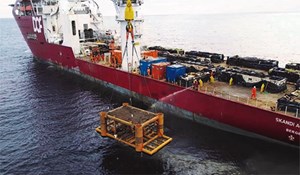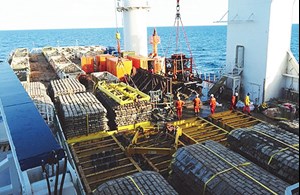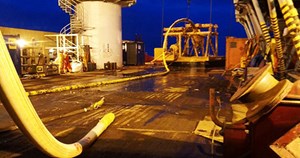Subsea technology: Achieving a 99% repurpose and recycle rate during decommissioning
A decommissioning project carried out by DOF Subsea, on behalf of Repsol Sinopec Resources UK, to project manage and provide engineering, preparation, removal and disposal (EPRD) services at Buchan and Hannay fields in the Central North Sea, achieved a 99% rate for the combined recycling and repurposing of recovered materials.
The offshore works, which were carried out over 74 days, using the company’s Skandi Acergy and Skandi Skansen vessels (Fig. 1), saw the recovery of 135 concrete mattresses weighing approximately 800 tonnes (Fig. 2), more than 12 km of rigid pipelines, SSIV/PLEM structures, 15.5 km of flexibles and umbilicals, spoolpieces and 1,500 grout bags and general debris.
The material was shipped to Aberdeen Harbour’s Clipper Quay in Scotland for dispersal, with 95% of the material being recycled and 4% being repurposed. Only 1% was sent to landfill as a last resort.
The recovered material was dispatched for a wide variety of uses. A total of 15 concrete mattresses was repurposed into aggregate and used in the roads at the £350,000 Aberdeen Harbour extension project. The plastic sheaths from the flexible risers and umbilicals were recycled by an approved supplier, and all metal was smelted.
DOF Subsea worked closely with Scotoil Services in Aberdeen throughout the process with any NORM-contaminated waste in metals or plastics removed by high-pressure cleaning at Scotoil before undergoing high-temperature incineration. The decontaminated metals and plastics were then recycled.
Previous success. This was the second decommissioning project carried out by the service provider on behalf of Repsol Sinopec in Buchan and Hannay fields. In 2019, the company performed EPRD services that included the 124-tonne mid-water arch (Fig. 3), still one of the largest structures ever decommissioned through Aberdeen Harbour. The project also included the recovery of risers (Fig. 4) and all associated equipment, achieving a combined recycling and repurposing rate of 97.7%.
DOF Subsea has been building its decommissioning portfolio over the past decade, and with a global support team of more than 120 engineers has delivered more than 30 projects around the world for major operators, resulting in an average reuse and recycling rate of 97%.
Later this year, the company’s decommissioning activity will enter a new phase in the waters around the UK, when it carries out a further wellhead severance and recovery project for a client in the Celtic Sea offshore Ireland. The campaign marks an extension to the company’s decommissioning work and represents an area of growth for the company. The scope of work will include the removal of 10 subsea production wellheads and four exploration and appraisal wellheads, two Christmas tree support piles and a number of tree legs from three different sites, as well as seabed debris removal.
The company will project manage the campaign, with responsibilities that include general management, administration, engineering, quality and HSE. It will also include planning, document control, procurement and material handling, project controls, surveys and inspections in addition to offshore and onshore supervision. The project being undertaken by the UK-based team follows on from decommissioning activity being undertaken by the company around the world.
Specialized equipment. The company owns a formidable fleet of vessels that are well-equipped to support the decommissioning services it delivers. The Celtic Sea project will use the Skandi Constructor, a subsea construction support vessel that was reconfigured and upgraded in response to increased activity in decommissioning, Fig. 5. The reconfiguration included an upgrade to a 250Te AHC crane and the addition of two new, powerful XLX-C WROVs. In addition, the mezzanine deck was removed to allow 1,240 m2 of clear deck. The upgrades will benefit both construction and decommissioning projects through a vessel highly capable of meeting today’s decommissioning market expectations.
The Skandi Acergy and Skandi Skansen, which were both used in the Buchan Hannay projects, are regular workhorses for the company’s UK-managed decommissioning projects. The Skandi Acergy carries a 400-tonne crane—the largest currently available to DOF Subsea from its fleet and the Skandi Skansen is an anchor-handling vessel that is commonly used when decommissioning floating units. The company also has access to a number of other vessels that can be deployed to meet different project requirements.
VALUE DELIVERED
DOF Subsea’s EVP-Atlantic Region Jan Kristian Haukeland said, “this project is a demonstration of our company’s capability to use our fleet of world-class vessels to deliver turnkey solutions to the subsea energy sectors, in this instance a decommissioning scope for a key repeat customer. Focusing on our company values, ‘respect, integrity, teamwork, excellence and safety,’ has enabled us to work with Repsol Sinopec to attain this impressive achievement of 99% recycling and repurposing at Buchan and Hannay.”
Head of Decommissioning at Repsol Sinopec Luis Batalla added, “we are delighted with this outcome as part of one of our biggest subsea decommissioning projects in the North Sea to date. A truly collaborative and open communication approach was taken on this project between Repsol Sinopec and DOF Subsea, and I have no doubt that this helped to facilitate the success and safe execution of this part of our decommissioning program. Our decommissioning strategy is focused on efficiency, performance management, innovative contracting models, technology development and fit-for-purpose design, which aligns well with DOF Subsea and their own way of working.”
ESG initiative. The latest project confirms DOF Subsea’s commitment to leading the way in championing environmental and social sustainability in the industry. Last year, the company was named as a Europe Climate Change Leader in the Financial Times’ Europe’s Climate Leaders 2021 report. Undertaken in cooperation with an independent data company, it reviewed tens of thousands of companies, scrutinizing existing greenhouse gas emissions to identify outstanding European companies that are successfully reducing their core GHG emissions, relative to their revenue.
The company also holds a B rating in the Carbon Disclosure Project, a global benchmark for the world’s cities and companies leading on environmental performance. The rating places DOF Subsea in the top 35% for environmental rating. DOF Subsea Chief Sustainability Officer Stig Clementsen said, “being named as one of only 300 companies in the Europe Climate Leaders Report was an important recognition for us on a number of levels. It clearly demonstrates our leadership in reducing our GHG emissions intensity. It is also another step in achieving our strategic objectives in shaping DOF Subsea for the future, in support of our strategy plan to uphold our position in the top five for environmental and social sustainability in our industry.”
Path forward. DOF Subsea is committed to improving the energy efficiency of its fleet. Several projects are already underway and will continue throughout 2022 and beyond, as the company moves toward its overall objective of reducing fuel consumption 40% by 2030.
- Advancing offshore decarbonization through electrification of FPSOs (March 2024)
- Subsea technology- Corrosion monitoring: From failure to success (February 2024)
- Driving MPD adoption with performance-enhancing technologies (January 2024)
- Digital transformation: A breakthrough year for digitalization in the offshore sector (January 2024)
- Offshore technology: Platform design: Is the next generation of offshore platforms changing offshore energy? (December 2023)
- 2024: A policy crossroads for American offshore energy (December 2023)







